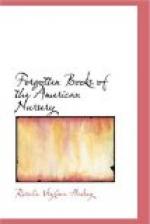As the century grew older other catechisms were printed. The number produced before the eighteenth century bears witness to the diverse views in a community in which they were considered an essential for every member, adult or child. Among the six hundred titles roughly computed as the output of the press by seventeen hundred in the new country, eleven different catechisms may be counted, with twenty editions in all; of these the titles of four indicate that they were designed for very little children. In each community the pastor appointed the catechism to be taught in the school, and joined the teacher in drilling the children in its questions and answers. Indeed, the answers were regarded as irrefutable in those uncritical days, and hence a strong shield and buckler against manifold temptations provided by “yt ould deluder Satan.” To offset the task of learning these doctrines of the church, it is probable that the mothers regaled the little ones with old folk-lore tales when the family gathered together around the great living-room fire in the winter evening, or asked eagerly for a bedtime story in the long summer twilight. Tales such as “Jack the Giant Killer,” “Tom Thumb,” the “Children in the Wood,” and “Guy of Warwick,” were orally current even among the plain people of England, though frowned upon by many of the Puritan element. Therefore it is at least presumable that these were all familiar to the colonists. In fact, it is known that John Dunton, in sixteen hundred and eighty-six, sold in his Boston warehouse “The History of Tom Thumb,” which he facetiously offered to an ignorant customer “in folio with Marginal notes.” Besides these orally related tales of enchantment, the children had a few simple pastimes, but at first the few toys were necessarily of home manufacture. On the whole, amusements were not encouraged, although “In the year sixteen hundred and ninety-five Mr. Higginson,” writes Mrs. Earle, “wrote from Massachusetts to his brother in England, that if toys were imported in small quantity to America, they would sell.” And a venture of this character was certainly made by seventeen hundred and twelve in Boston. Still, these were the exception in a commonwealth where amusements were considered as wiles of the Devil, against whom the ministers constantly warned the congregations committed to their charge.
Home in the seventeenth century—and indeed in the eighteenth century—was a place where for children the rule “to be seen, not heard,” was strictly enforced. To read Judge Sewall’s diary is to be convinced that for children to obtain any importance in life, death was necessary. Funerals of little ones were of frequent occurrence, and were conducted with great ceremony, in which pomp and meagre preparation were strangely mingled. Baby Henry Sewall’s funeral procession, for instance, included eight ministers, the governor and magistrates of the county, and two nurses who bore the little body to the grave, into which, half full of water from the raging storm, the rude coffin was lowered. Death was kept before the eyes of every member of the colony; even two-year-old babies learned such mournful verse as this:




